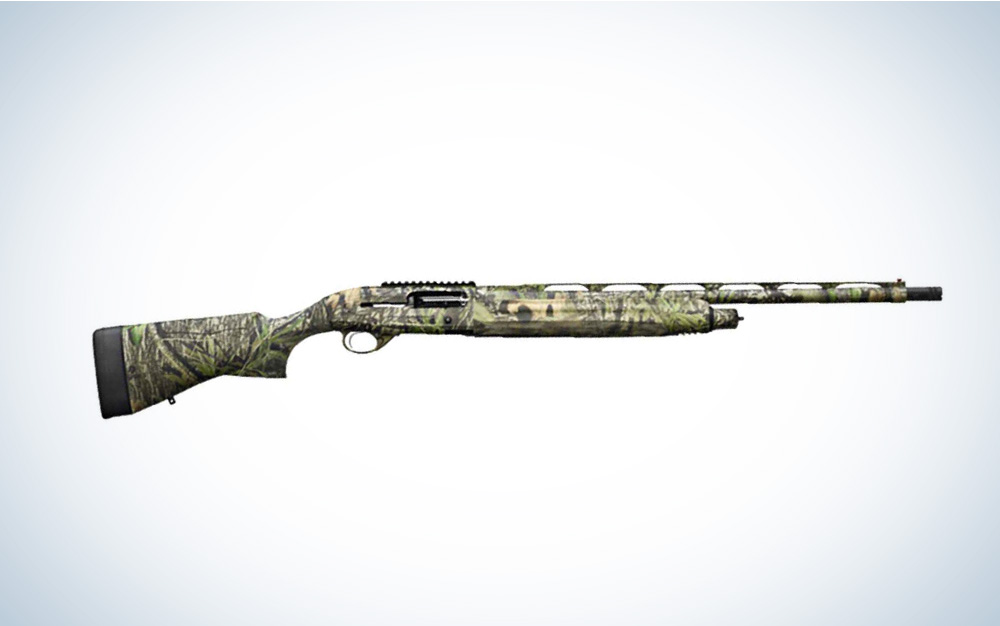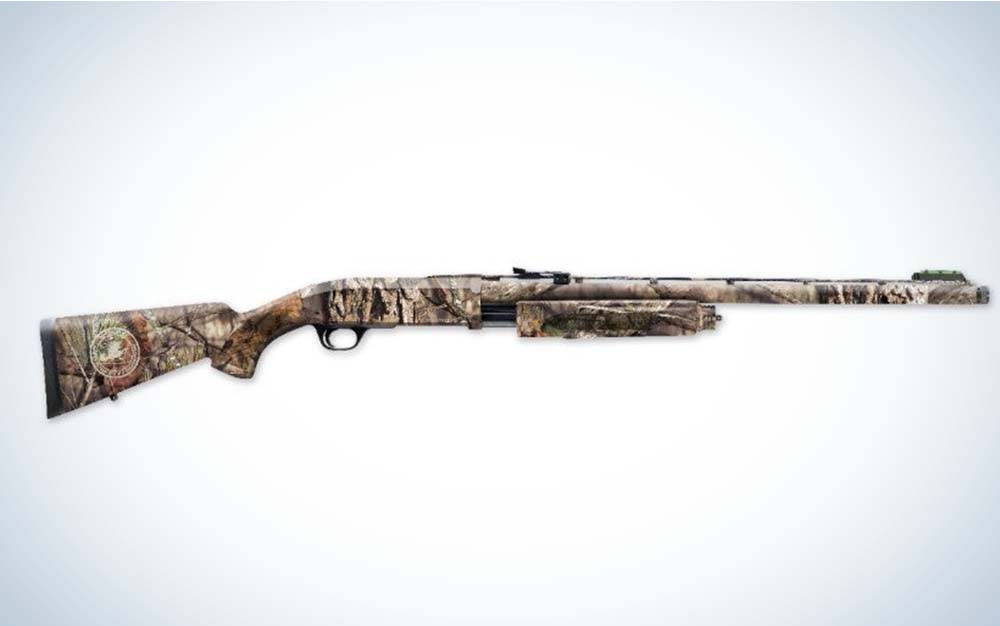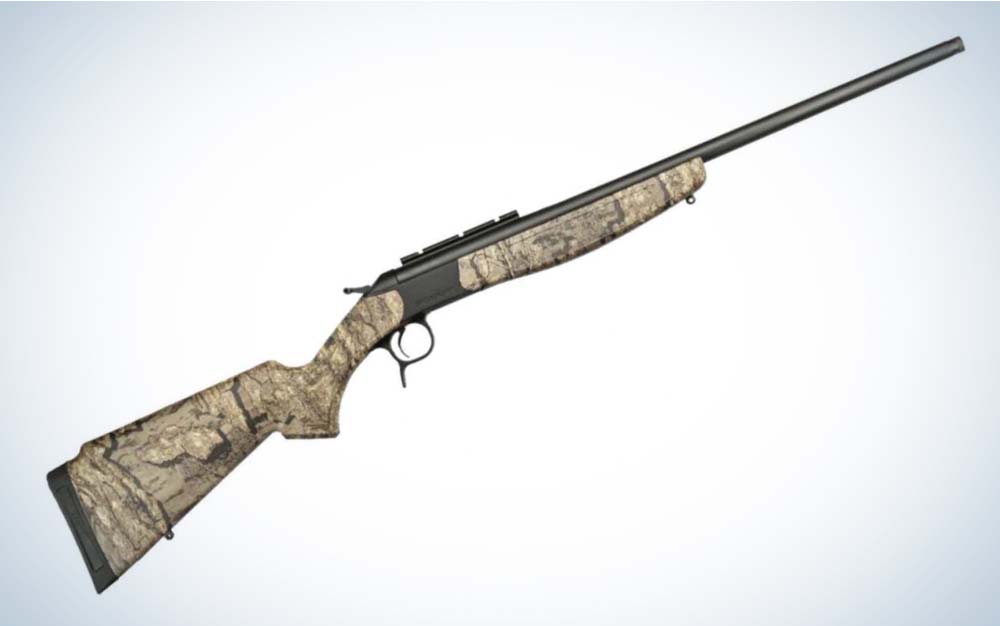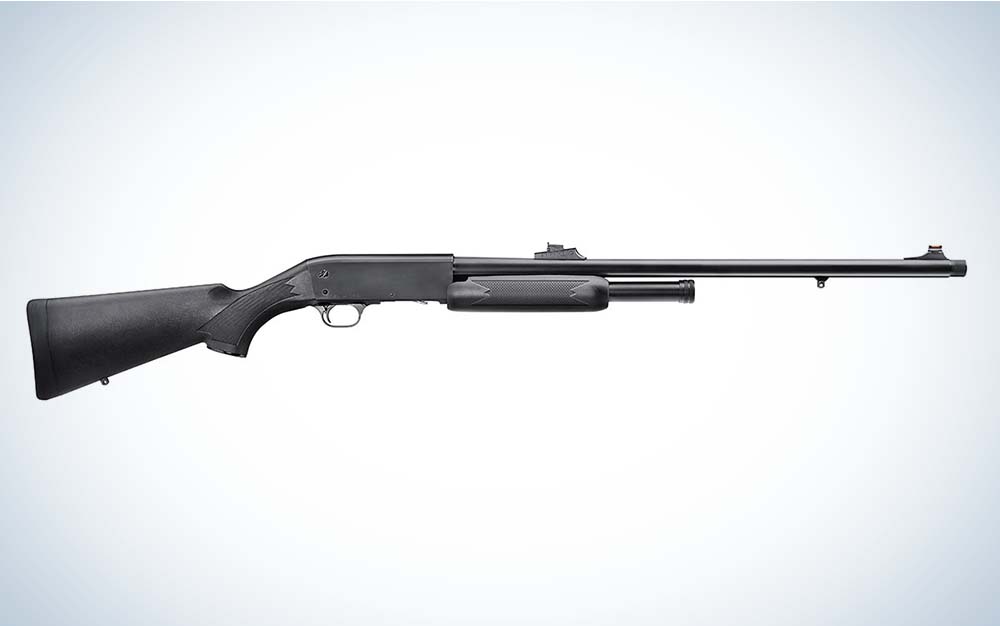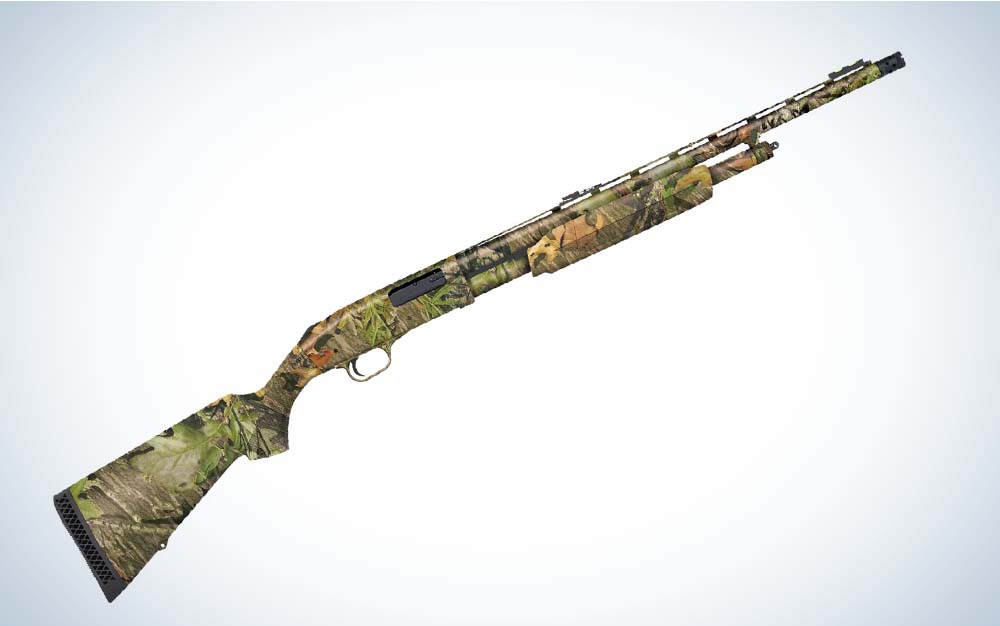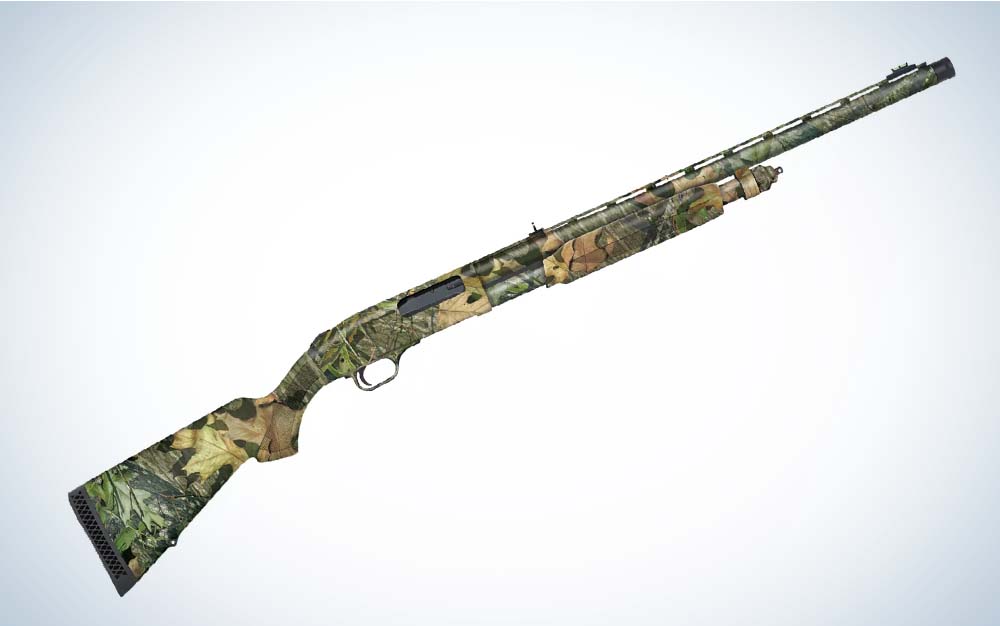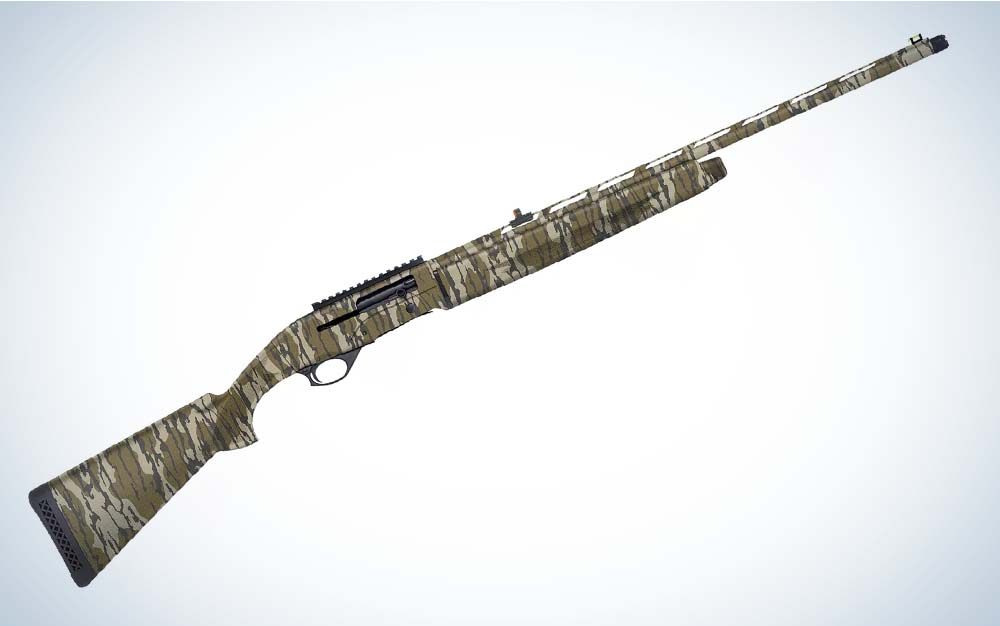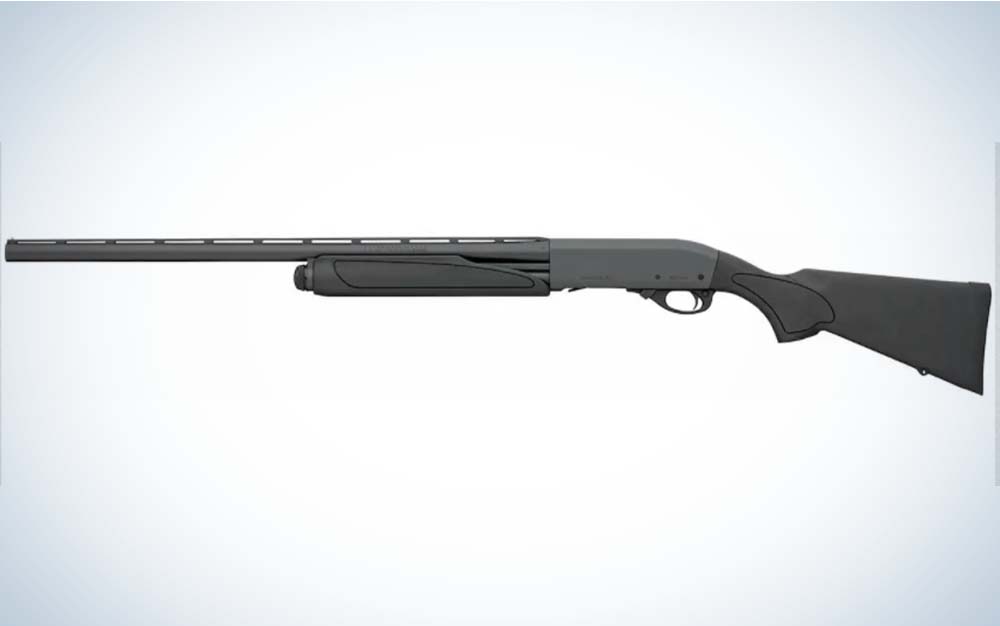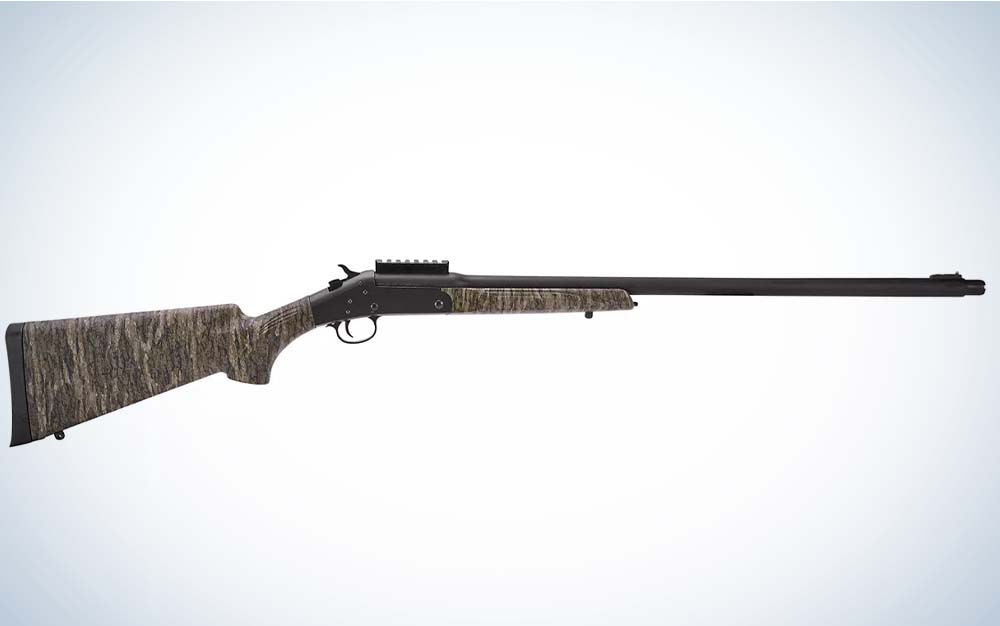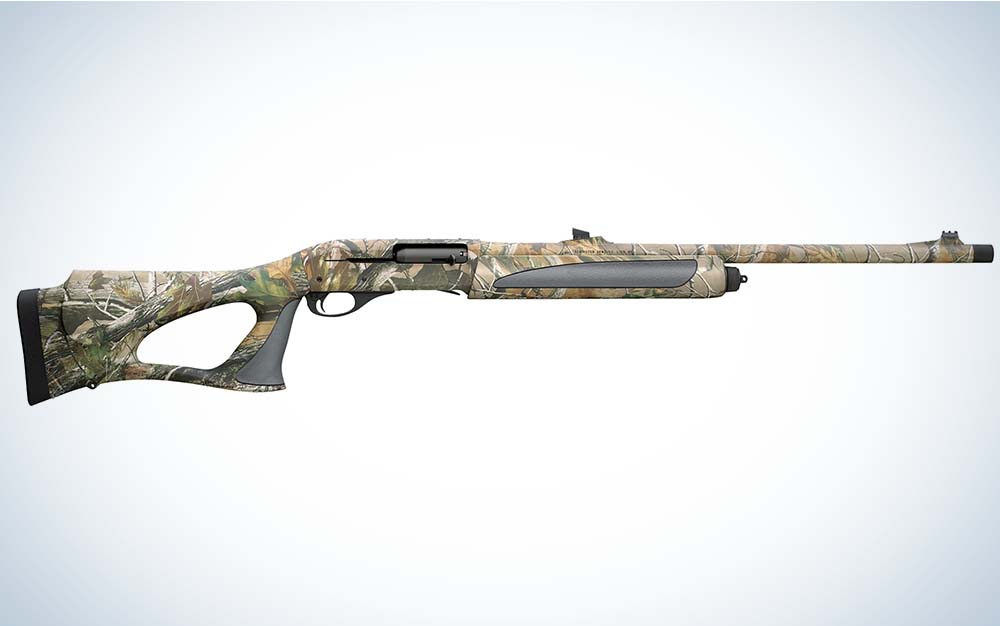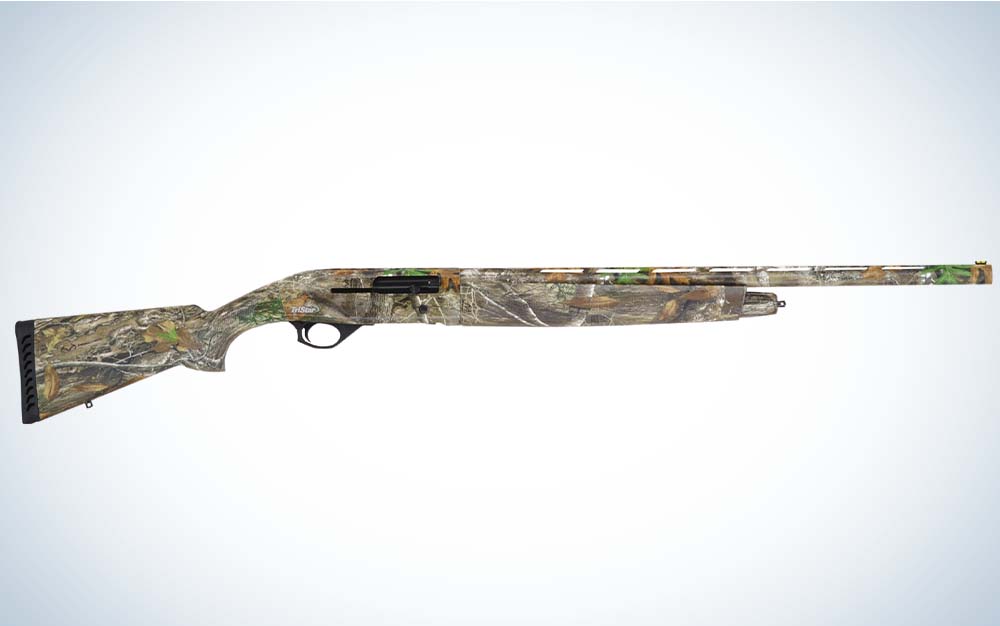We may earn revenue from the products available on this page and participate in affiliate programs. Learn More ›
Updated Mar 3, 2023 6:09 PM
One of the hottest trends in the shotgun market is the “turkey gun.” Today, the best turkey shotguns are typically variants of a shotgun that was designed for waterfowl or small game hunters with stocks and barrels that are shortened to make the guns easier to carry and more maneuverable in tight cover. Gun makers added pistol grips for a more rifle-like shooting experience and many turkey guns have receivers that are drilled and tapped for optics. They all come with chokes designed specifically for printing tight, gobbler-killing patterns.
There are as many variations of a turkey hunting gun as there are versions of turkey hunting styles. There are hefty, long range guns for hunters who want to sit in a blind and kill turkeys beyond 50 yards. There are compact, maneuverable guns for private-land hunters who want to crawl their way through the season, reaping turkeys at close range. And there are classic pump shotguns for traditionalists who believe the only way to kill a turkey is in the woods with your back resting against a tree. So our team of editors put together a list of the best turkey shotguns for all the different styles of turkey hunting and types of turkey hunters.
History of the Turkey Gun
Turkey-specific shotguns haven’t been around all that long when you consider hunters have been taking break-actions and repeaters into the woods to chase wild game for hundreds of years.
During the Depression, the turkey population dipped to 30,000 birds, so there wasn’t a need to build a platform that catered specifically to turkey hunters. For much of the 20th century, your turkey gun was whatever shotgun you owned. That’s not the case anymore. With the restoration of turkey populations across the U.S. and Canada (there were almost 7 million birds between both countries by the early 2000s), the dedicated turkey gun became popular.
Read Next: Best Camo for Turkey Hunting
Best Turkey Shotguns: Reviews & Recommendations
Best Custom Turkey Hunting Gun: Benelli Super Black Eagle 3 Turkey Performance Shop
Key Features
- 24-inch barrel
- Burris FastFire II red-dot
- Mossy Oak camouflage finish
- 3½-inch chamber
Pros
- Pistol grip adds steadiness
- Burris optic delivers better accuracy
- Enlarged bolt handle and “slammer button” bolt release make the gun easier to operate
Cons
- It’s light for a turkey gun, which means more recoil
- Expensive
Rob Roberts is a master at getting the most out of shotgun pattern performance. The Arkansas gunsmith, known for his aftermarket choke tubes, teamed up with Benelli on the SBE3 Turkey Performance Shop. Roberts lengthens the forcing cones inside the 24-inch barrel and adds a custom .655 choke to deliver superior pattern density. The 12-gauge also comes with a Burris FastFire II red-dot so hunters can be more accurate with shot placement. A 3½-inch gun that only weighs 6.8 pounds, the SBE3 is inertia-driven, so 2-ounce turkey loads will sting your shoulder a bit more than if you were shooting a gas gun. An extended pistol grip allows you to better stabilize the gun, which is important in turkey hunting because you’ll be aiming the gun like it’s a rifle. —Joe Genzel
Best Gas Semi-Auto Turkey Gun: Beretta A350 Xtrema Turkey
Key Features
- 24-inch barrel
- Aluminum Picatinny rail
- Micro recoil pad
- 3½-inch chamber
Pros
- Gas-operated for softer recoil
- Drilled and tapped for an optic
Cons
- Expensive for a dedicated turkey gun
- At that price point, it should come with an optic
Released in 2017, the A350 was Beretta’s first dedicated 3½-inch auto-loader for turkey hunters. The A350 debuted as a waterfowl shotgun, bridging the gap in price between the A300 Outlander and A400 Xtreme. Beretta shortened the barrel to 24 inches on the turkey model and added an aluminum rail on the top of the action—which leads into a stepped, ventilated rib—for mounting an optic. It’s a gas gun, so hunters will feel less recoil than with an inertia-driven gun. Beretta also equipped the shotgun with its Blink system, which cycles shotshells fast, though it’s not a necessity on a turkey gun unless you miss and need a quick follow up shot. There is a Micro Core recoil pad screwed into the buttstock to help absorb the recoil of heavy turkey loads. An extended extra-full turkey choke comes standard. It’s an Optima-Choke system, which is used by many of Beretta’s high-end guns, like the DT11 and DT10. The camouflage finish of the A350 is in Mossy Oak Obsession. —J.G.
Best Bottom-Eject Turkey Gun: Browning BPS NWTF Turkey
Key Features
- 24-inch barrel
- Pump action
- Bottom eject
- 3½-inch chamber
- HiViz front sight
Pros
- Pump-action reliability
- Bottom eject keeps action clean
- Optics ready
Cons
- It’s heavy (almost 8 pounds)
- Pricey: BPS shotguns are almost $1,000
The BPS was made for turkey hunters. Since the load gate and ejection port are one in the same, there’s less of a chance for mud and grime to find their way into the chamber and gunk up your gun. That’s important for turkey hunters, who are mostly sitting on the forest floor. You can buy the BPS in a 3½-inch chamber, but I like the 3-inch model for turkey hunting. First, the travel on the fore-end when you need to eject a spent shotshell and load a new one is shorter, and the gun itself is two inches shorter than the 3½-inch 12-gauge. The receiver is drilled and tapped for an optic, plus there is a 4-in-1 Hi-Viz fiber-optic sight system, which includes a rear and front sight for better accuracy. The downside to a BPS is its weight. They are nearly 8-pound guns even in the composite model (wood and steel BPS’ are heavier). But the weight tames much of the felt recoil, and there are sling swivels, so you can haul the gun over the shoulder if you buy a strap. —J.G.
Best 10-Gauge Turkey Hunting Gun: Browning Gold Light
Key Features
- Gas operated
- Low recoil
- 3½-inch chamber
- Inflex recoil pad
Pros
- Manageable recoil
- Superior shotshell payloads
- Well balanced
Cons
- It’s a heavy 10-pound gun
- Length (the Gold Light is 4-feet long)
The almost-10-pound 10-gauge Gold Light is anything but light. That said, if you’re not a run-and-gun turkey hunter, a 10 loaded with a 3½-inch lead or tungsten shotshell that has a shot charge of 2 ounces or more is an absolute hammer on gobblers. The knock on 10 gauges is that they shoot bigger shells so they must produce more recoil, but that’s not the case. Since the Gold Light is a heavy gas-driven gun, the recoil is comparable to a 12-gauge auto. Turkey hunters should opt for the shorter 26-inch barrel, but this is a long shogun (48 inches with a 26-inch barrel and 50 inches with a 28-inch barrel), so it’s not ideal for river-bottom thickets or heavily forested ridgelines. It can be hard to find turkey ammo for 10s because there are only two in production (the BPS is the other), but it’s an ideal gauge for tough old toms because of the increased payload capability of its shotshells. The Gold Light is a well-balanced gun, and though it is nearly 10 pounds, that weight is evenly distributed, which makes it easier to carry. —J.G.
Best Youth Turkey Hunting Shotgun: CVA Scout Compact
Key Features
- Scope rail
- Jebs X-Full Turkey choke
- 22-inches long total
Pros
- Lightweight
- Virtually no recoil
- Aftermarket choke comes standard
- Price
- Lifetime warranty
Cons
- Hammer gun, so you must cock it
- Not legal in every state
Single-shots are making a comeback in the turkey woods and .410s (where legal) have carved out a niche among turkey hunters willing to pay the price for TSS shotshells. If you desire both those elements in a shotgun, the Scout is an ideal platform. The scope rail allows you to mount almost any optic to it (you’ll need one shooting a .410). Plus, the comb of the stock is raised like you would find on a rifle to make it easier to see through a mounted scope or red dot. It’s only a 6-pound gun, and just 22 inches long without the included Jebs X-Full choke. Length of pull can be adjusted from 13 to 14 inches, so even though the Scout is “compact” it’s still a comfortable gun to shoot regardless of your size. There is a thick recoil pad affixed to the buttstock, but with the dainty charge weights of .410 ammo, recoil is a non-issue. It is a hammer gun, so you will have to cock it before shooting, which does take extra time you may not have if a longbeard gives you a tight shot window. —J.G.
Best Classic Turkey Hunting Gun: Ithaca Model 37 Turkey Slayer
Key Features
- Bottom eject
- 24-inch barrel
- Rifle sights
Pros
- Reliability of a pump shotgun
- Better accuracy with rifle sights
- Manageable weight for a pump
Cons
- Pricey for a pump
- No wood and steel option
- Cross-bolt safety on a bottom eject
The 37 has enjoyed one of the longest runs in pump shotgun history. Based on a John Browning design, the Ithaca Model 37 was originally set to debut in 1933 after the Browning patents expired. But it was discovered that gunmaker John Pederson also held some of the design patents, and so Ithaca had to wait four more years for those to expire. The 37 Turkey Slayer is still being made and available in a 12- and 20-gauge model with a 24-inch barrel. There are raised rifle sights just forward of the receiver and at the muzzle for better accuracy, and the Turkey Slayer comes in a black synthetic finish for added durability. It’s not an overly heavy turkey gun in 20-gauge at 7.2 pounds but the 12 is over 8 pounds. A bottom-eject pump, the Turkey Slayer will keep the elements away from your shotshell, which is critical if you’re sitting through a spring rain or freak snow shower. It’s not unheard of for moisture to make its way into the action of side eject shotguns and contaminate a shell’s gunpowder, rendering it useless. Or the water can work its way into the firing pin, causing a light strike of the shotshell’s primer. —J.G.
Best Budget Pump: Mossberg 500 Turkey
Key Features
- 20-inch barrel
- Tang-mounted safety
- X-Factor choke
- 3-inch chamber
Pros
- Long history of reliability
- Ambidextrous safety
- Short barrel
Cons
- Heavy recoil
- Has a plastic exterior feel
There’s probably no other shotgun manufacturer more dedicated to turkey hunting than Mossberg. Just about every time Mossberg comes out with a new shotgun, it eventually is made available in a turkey platform. Its most iconic pump is the 500, and the turkey model is an ideal gobbler gun. Just 40 inches long—the barrel is 20 inches—the 500 is great for hunting tight cover. The X-Factor choke comes standard, and a tang-mounted safety is perfect if you need to kill a longbeard with your off-hand. The length of pull is only 13.875 inches, and the travel of the fore-end is short in case you need to get a second shot off quickly. There is a front fiber-optic sight for quicker target acquisition, and the 7-pound 12-gauge (get ready for some serious recoil) is finished in Mossy Oak Obsession. The 500 is also available in a .410-bore and 20-gauge. —J.G.
Best 3.5-Inch Pump: Mossberg 835 Ulti-Mag Turkey
Key Features
- 3.5-inch chamber
- 24-inch barrel
- Tang-mounted safety
Pros
- 3.5-inch capable
- Super durable
Cons
- Heavier than the 500
- More expensive than the 500
- Cheap, flimsy sights
If you like the Mossberg 500 features but you’re a maniac and want to shoot 3.5-inch turkey loads, then the Mossberg 835 Ulti-Mag Turkey is the shotgun for you. It has a longer 24-inch barrel and weighs a half pound more than the 500, which is welcome weight to help soak up all that recoil.
I’ve hunted across the country with my 835 over the last seven turkey seasons and what I love most about it is that it’s a beater shotgun. It always cycles and always goes bang when I squeeze the trigger. It gets splashed with snow, rain, mud, and turkey blood every season and just keeps running (now that I think about it, I’m not sure that I’ve actually ever cleaned the gun).

It came with a full (.695) choke that I’ve never seen a need to swap out, which is good because it’s probably rusted in there by now. With top-end TSS loads it shoots killer patterns at 60 yards—and probably farther but I’ve never tried it. The only real downside of the 835 Turkey is that my version came with cheap, flimsy sights. My rear sight fell off at some point during its first season. I solved this by adding a Leupold Freedom red-dot optic. To get the proper comb height in order to see through my new sight, I stole a trick from Dave Petzal and taped a few strips of foam to the stock using green duct tape. It works wonderfully, and really adds to the aesthetic of my beater gun. But wait, you might say. Do you really need 3.5-inch TSS loads to kill a turkey? To that I’d respond, need has nothing to do with it. —Alex Robinson
Best Sub-Gauge Semi-Auto .410: Mossberg SA-410 Turkey
Key Features
- 3-inch chamber
- .410-bore
- Semi automatic
Pros
- XX-Full turkey choke
- Gas operated
- Mossy Oak camo
Cons
- Not legal in every state for turkey hunting
- It’s long for a .410 turkey gun
There aren’t too many .410 auto-loaders out there, but the platform is becoming popular with turkey and flooded timber duck hunters as more TSS shotshell offerings are made available. Mossberg was one of the first manufacturers to offer the .410 auto in a turkey gun. The SA-410 is outfitted with a top rail for mounting and optic, which is almost a necessity if you’re going to shoot a gobbler with a .410. As you travel further down the 26-inch barrel there is a ghost ring sight followed by a raised fiber-optic just before the muzzle.
Ghost ring sights allow you to put a bead on an incoming tom with better precision. If you can line up the dot with the base of the loingbeard’s neck, it’s a done deal. The SA-410 had a fixed 13¾-inch length of pull, but you could buy an aftermarket recoil pad and slide it over the stock to increase that. Chambered for 3-inch loads, an XX-Full turkey choke is included with the .410. It weighs 6½ pounds, and has a 26-inch barrel, but is 46 inches in total length, a little long for a sub-gauge turkey gun. The gas-operated Mossberg is finished in Mossy Oak Bottomland camo. —J.G.
Best Patterning Pump: Remington 870 Turkey Camo
Key Features
- 21-inch barrel
- X-Full Rem turkey choke
- HiViz front sight
- 3-inch chamber
- 7.25 pounds
Pros
- Steel receiver
- Recoil better than most
- Durable finish
Cons
Turkey hunters will appreciate the 21-inch barrel of the 870 Turkey, which makes it easy to reposition for a better shot if a gobbler comes in from an unexpected direction. The shorter barrel cuts some of the weight from traditional 26- and 28-inch barrels, and it balances nicely for those times when you need to make an off-hand or awkward shot.
Like most turkey guns, this one has everything you need to start turkey hunting without buying additional accessories. The extra full choke patterns well depending on the ammo you use, and hunters who want to dial in their patterns can find an assortment of aftermarket chokes for the 870. Similarly, the HiViz single bead lines up great but doesn’t feel as sturdy as the rest of the gun, but you can easily replace them for cheap. The gun has a matte finish on the steel receiver and barrel, plus Mossy Oak Break-Up on the stock and fore-end.
If you’re also looking for a budget gun that can take a licking and keep on ticking, look no further. By the end of every turkey season, I’m always amazed at how much dirt and debris I clean off this gun, and I’ve never had a misfire or cycling issue. It’s crawled through mud, cut hay fields with standing water, and even bounced on concrete a time or two.
Unlike other turkey guns (I won’t mention), the 870 doesn’t punish you when you shoot it. The weight absorbs most of the recoil, and it’s never given me a shiner even if I had my cheek to close to the stock.
I’ve used 870s almost exclusively since I started turkey hunting, and my first one came from my grandfather who found it on a used gun rack. The worn finish around the receiver is from where me and the previous owner(s) gripped and toted it through the woods, and they also swapped the camo stock and forend for glossy Wingmaster furniture. But I never bothered to change it because there’s nothing wrong with having a classy turkey killer. It may not be a true Wingmaster, but this gun’s no pretender when it comes to dropping toms. Besides, it’s a wingmaster in its own right. For years, especially in college, I ran it with a Primos Tight Wad choke and whatever turkey ammo I could find. Sure, I could probably shoot tighter patterns with TSS loads or blends, but this budget gun loves budget ammo. And there hasn’t been a gobbler strut within 40 yards of this gun to change that yet.—Adam Moore
Best Single-Shot .410: Stevens 301 Turkey Obsession .410
Key Features
- 26-inch barrel
- 5.07 pounds
- 3-inch chamber
- Removable one-piece rail
- Extra-full choke tube
Pros
- Lightweight
- Easily fitted with optics
- Matte finish
Cons
- Single shot
- Less room for error with a .410
- .410s aren’t legal to turkey hunt with in all states
Advanced turkey loads and chokes have turned the .410 from a small game gun to a deadly accurate turkey slayer. The Stevens 310 Turkey Obsession makes a great, lightweight option—even with its 26-inch barrel—if you tend to put dozens of miles under your boots every turkey season. And your arms shouldn’t shake after holding your gun at the ready for several minutes when you’re waiting for a shot opportunity.
The Stevens 310 comes with a rail that you can easily remove with two screws or equip with an optic. I shot a Truglo red-dot on this gun and it produced deadly patterns at 30 yards with the stock choke. But when I switched to a Carlson’s TSS choke and Apex Ninja 3-inch loads, I was able to get plenty of pellets on paper at 40 yards. Even though it’s a single shot if you have a shell holder on the stock you can quickly reload thanks to the fast ejector that doesn’t stick like the old Stevens model. —A.M.
Best Classic Semi-Auto: Remington 1100 Turkey
Key Features
- Gas driven
- Thumbhole stock
- 12-gauge
Pros
- Thumbhole stock offers better accuracy
- Rubber grip inlays
- Rem turkey choke
Cons
- No longer in production
- Notoriously loud with heavy recoil
Introduced in the 1960s, the first 12-gauge 1100s could only shoot 2¾-inch shotshells, but there were soon 3-inch magnum variants, and eventually the gas guns were built for turkey hunters. The 1100 turkey gun is actually an 11-87. The platform was updated in 1987 to include a pressure compensation valve that allowed the shotgun to shoot light target loads on up to heavy 2-ounce turkey shells. It has a thumbhole stock, which is used by rifle shooters for better accuracy. The comb of the stock is also slightly raised, making it easier to get a better cheek weld as you look down the sight plane of the barrel. Rubber inlays on the pistol grip and fore-end will give you a better grip on the 11-87 in inclement weather, or when it gets hot and your palms get sweaty. There is also an adjustable rear sight, and a raised front fiber-optic to make precision shots on hung up toms. This shotgun is no longer in production, but can still be found on the used market. —J.G.
Most Underrated Turkey Gun: TriStar Viper G2 Turkey
Key Features
- 3-inch chamber
- Pistol grip
- Picatinny rail
- Gas operated
Pros
- Price
- Gas driven
- Molded pistol grip
Cons
- TriStar shotguns can be hard to find locally
TriStar doesn’t get enough credit for the functionality and reliability of its gas-operated shotguns. They are modeled after Berettas, and I would argue you get more for less money in the G2 Turkey than you would in the A350. The G2 comes with a molded pistol grip, which helps keep the gun steady but also assists in mitigating recoil because all that force caused from the heavy shot charge is not going solely into your shoulder. A 3-inch gun, the G2 includes a removable Picatinny rail, so you can use an optic, and a fiber-optic sight is mounted at the muzzle. A Beretta-style extended turkey choke comes standard, and there is also a thick recoil pad affixed to the buttstock to help tame recoil. A five-year warranty is included. —J.G.
Best Affordable Semi-Auto Turkey Gun: Winchester SX4 NWTF Cantilever Turkey
Key Features
- Available in 12- (3½-inch) or 20-gauge (3-inch)
- 24-inch barrel
- Invector-Plus extended choke system, includes extra full turkey
- Adjustable rear sight
- Weaver-style cantilever rail design for attaching an optic
- $1,150 MSRP
Pros
- 24-inch barrel is convenient for running and gunning and tight hides
- Semi-auto action runs without a hitch
- A portion of sales goes to NWTF to support wild turkey conservation
Cons
- The fit and finish falls short of what you would expect for the price—ran out of adjustment on the rear sight, which could’ve been solved by mounting an optic
If you want a dedicated turkey gun built around a reliable autoloader, you have to consider the SX4 NWTF Cantilever Turkey. Winchester updated the SX3’s ergonomics by including a rounder pistol grip and a textured grip, which makes this shotgun easy to handle even if you’re sweating or sitting in the rain. The chrome-plated chamber and bore keep the action running smoothly, and when the sun does start shining, the flat-finish camo doesn’t glare at all. Without the plug (you must have one in to legally turkey hunt), the magazine can hold four 2 3/4-inch shells, and the 12-gauge will accommodate up to a 3½-inch load. You can mount a traditional scope or a red-dot on the rail, or simply use the open fiber-optic sights. —Natalie Krebs
Best Bolt-Action Turkey Gun: Savage 212 Turkey
Key Features
- Bolt-action built off the 110
- 3-inch chamber
- User-adjustable AccuTrigger
- 22-inch barrel
Pros
- 110 platform is iconic
- Adjustable trigger
- Optics ready
Cons
- Hefty (8.25 pounds without optic)
- Doesn’t run as smoothly as a rifle
This shotgun brings rifle marksmanship to the turkey woods. It’s built off Savage’s iconic 110 rifle platform, includes the excellent AccuTrigger (Savage’s adjustable, two-stage trigger), and features the modular AccuFit stock so you can adjust length-of-pull and comb height, which is especially useful when adding an optic. Speaking of optics, you will have to buy one for this rig as it comes with no sights. The shotgun does include a two-round box magazine.
I hunted with the 212 Turkey a few years ago for Gould’s turkeys in Mexico, and found that it handled just like a magnum-caliber rifle would. If you intend to mount a scope on this gun, like one of the trendy new LPVOs, mount it as far forward as the eye relief will allow. You don’t want the scope crashing into your eyebrow with 12-gauge, turkey load force. Or just cut down on the recoil altogether and go with the 20-gauge version. The only downside of Savage’s turkey gun is that it did not run as smoothly as I’d hoped. It takes a good amount of force to rack the bolt back and run a shell from the magazine into the chamber. It’s not the smooth, fast experience of running the bolt on a 110 rifle. And this really is the only reminder that this shotgun is, afterall, a shotgun. —A.R.
How to Choose a Turkey Shotgun
With the right choke and load combination, any turkey gun on this list will shoot excellent patterns at realistic hunting ranges. So if your primary interest is to buy a turkey shotgun for reliability, you can’t beat a pump-action. But that platform is also likely to produce the most recoil (along with break-action options) unless the gun has more weight to it. Gas-driven autoloaders are soft shooters, but are also typically the most expensive. Inertia shotguns are light —and less expensive than gas guns—but they don’t handle recoil as well. And if the gun has a rotating bolt head, it may not send the shotshell into battery if you ease the action forward like so many turkey hunters do to load their shotguns (it keeps noise at a minimum). If you’re buying a dedicated turkey gun for the first time, it’s smart to start with an affordable model, and work your way up.
Read Next: The Best Turkey Loads

FAQs
Q: What’s the best turkey shotgun platform?
Most turkey hunters like to shoot a 12- or 20-gauge pump-action shotgun. The most common models are a Remington 870 Express or the Mossberg 500 or 835. The 870s are fairly light and like with any pump gun, you can also easily remove a shell from the chamber if you need to make a move. With the rise in popularity of TSS shotshells, many hardcore turkey hunters are opting for 28-gauge and even .410 shotguns because they are so light and manuverable—and they’re lighter on recoil. These days you’ll find plenty of sub-gauge guns in pump, semi-auto, and brake-action platforms.
Q: Do you need an optic?
I shot “open sights” on my turkey shotgun for a long time, and still do. But I have also shot turkey guns with a red-dot reflex sight and they will greatly improve your accuracy. Red-dot sights also help you get on target more quickly because there’s only one point of alignment compared to an open sight (or iron sight) which has two—rear sight to front sight to target (though some hunters, myself included, shoot turkeys like they would a duck and don’t use a sight to line up the shot at all).
This concept also helps if you have to take a shot from an awkward position. For example if the turkey comes in behind and you have to twist around to shoot. Even if your head isn’t perfectly mounted on the gun and you’re not looking straight down the barrel, put the red dot on target and you’ll drop the bird. Lastly, new turkey hunters—just like a new handgun shooter—will benefit from a red-dot, because all they have to do is put that ball of fire on the turkey’s neck and squeeze the trigger.
Q: What’s the best turkey shotshell option?
If you can afford TSS, I would recommend buying it. You don’t need tungsten to kill a turkey, but I’ve shot most of mine with straight TSS or tungsten-iron shotshells in the last 10 years and they are absolute hammers. I’ve done some penetration testing with TSS, and it will go through two sheets of ½-inch drywall with ease at 40 yards. Lead will also make it through, but with far fewer pellets.
Why Trust Outdoor Life?
Since 1898, OL has been a leading authority in testing and reviewing hunting gear, fishing tackle, guns and shooting equipment, and much more. We have more than a century-long history of evaluating products, and we’re now bringing that expertise to online reviews. Our editors are experienced outdoorsmen and women, and most importantly, we’re trained journalists. We prioritize field testing and objective data when reviewing products. We conduct interviews with gear manufacturers and engineers as well as outdoor experts so that our readers have an understanding of how and why a product works—or doesn’t.
Advertising does not influence our gear reviews and it never will. While we always focus our coverage on standout products—because we want our readers to be aware of the latest and greatest gear—we also cover the flaws and quirks of any given product.
Final Thoughts
Many hunters will put a turkey choke on a shotgun they already own and take it turkey hunting. That certainly works, but dedicated turkey shotguns come in all shapes and sizes with a wide variety of features. When you’re shooting a shotgun like a rifle from the ground amongst the trees, it’s better to have a raised comb and shorter barrel. You don’t need a turkey gun to kill a longbeard, but modern turkey-specific shotguns have earned such popularity because they’re more effective.
Read Next: Best Turkey Vests

